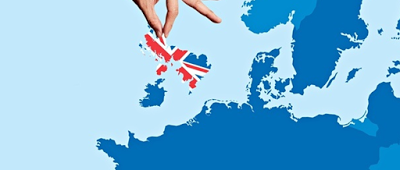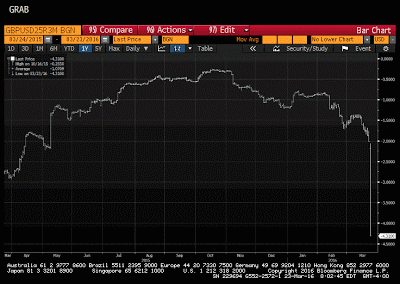Summary:
The UK referendum is three months away. Three-month options are a common benchmark for various market segments; from speculators, to fund managers to corporations. Events over the past week have raised the risks that the UK votes to leave the EU. The market has responded forcefully today, and even if you only follow the spot market, what is happening in the options market is significant. First, three-month volatility has jumped 2.6 percentage points to 14.5%. It appears to be the largest single-day increase in sterling volatility since 2001. The level is the highest since 2010. The move in the spot market is modest. The increase in implied (embedded in the options price) is not being driven by an increase in historical (actual) volatility. The three-month historic volatility is little changed on the day. That said it has trended higher since mid-January's 7.3% level to 10.3% now, which is the highest since the middle of last year. The rise in implied volatility with a flat historic volatility suggests that the driver is supply and, more likely, demand for options. This is to say the increase in implied volatility now points to the buying options. And if we take it one step further, the options that are being bought, are sterling puts. Put-call parity means that puts and calls equidistant from the forward strike should trade for the same price.
Topics:
Marc Chandler considers the following as important: Featured, FX Trends, Great Graphic, newsletter, Options, Sterling
This could be interesting, too:
The UK referendum is three months away. Three-month options are a common benchmark for various market segments; from speculators, to fund managers to corporations. Events over the past week have raised the risks that the UK votes to leave the EU. The market has responded forcefully today, and even if you only follow the spot market, what is happening in the options market is significant. First, three-month volatility has jumped 2.6 percentage points to 14.5%. It appears to be the largest single-day increase in sterling volatility since 2001. The level is the highest since 2010. The move in the spot market is modest. The increase in implied (embedded in the options price) is not being driven by an increase in historical (actual) volatility. The three-month historic volatility is little changed on the day. That said it has trended higher since mid-January's 7.3% level to 10.3% now, which is the highest since the middle of last year. The rise in implied volatility with a flat historic volatility suggests that the driver is supply and, more likely, demand for options. This is to say the increase in implied volatility now points to the buying options. And if we take it one step further, the options that are being bought, are sterling puts. Put-call parity means that puts and calls equidistant from the forward strike should trade for the same price.
Topics:
Marc Chandler considers the following as important: Featured, FX Trends, Great Graphic, newsletter, Options, Sterling
This could be interesting, too:
Nachrichten Ticker - www.finanzen.ch writes Die Performance der Kryptowährungen in KW 9: Das hat sich bei Bitcoin, Ether & Co. getan
Nachrichten Ticker - www.finanzen.ch writes Wer verbirgt sich hinter der Ethereum-Technologie?
Martin Hartmann writes Eine Analyse nach den Lehren von Milton Friedman
Marc Chandler writes March 2025 Monthly
The UK referendum is three months away. Three-month options are a common benchmark for various market segments; from speculators, to fund managers to corporations. Events over the past week have raised the risks that the UK votes to leave the EU.
The market has responded forcefully today, and even if you only follow the spot market, what is happening in the options market is significant. First, three-month volatility has jumped 2.6 percentage points to 14.5%. It appears to be the largest single-day increase in sterling volatility since 2001. The level is the highest since 2010.
The move in the spot market is modest. The increase in implied (embedded in the options price) is not being driven by an increase in historical (actual) volatility. The three-month historic volatility is little changed on the day. That said it has trended higher since mid-January's 7.3% level to 10.3% now, which is the highest since the middle of last year.
The rise in implied volatility with a flat historic volatility suggests that the driver is supply and, more likely, demand for options. This is to say the increase in implied volatility now points to the buying options. And if we take it one step further, the options that are being bought, are sterling puts.
Put-call parity means that puts and calls equidistant from the forward strike should trade for the same price. To the extent, they don't show a bias in the market. That bias stands at a record today. A commonly used reference point for the risk-reversal is three-month tenor (25 delta). It is depicted in the Great Graphic, from Bloomberg, below:
The chart shows the discount of sterling calls to puts. The calls are selling at a 4.2% discount to puts. It is the largest single day move in the risk-reversal since 2009.
Since 2010, the discount has not been more than 3%. In 2009 and 2009 it touched 4% briefly. Today is the largest call discount, which means the largest premium for puts since at least 2003 when the Bloomberg time series began.
The price action dovetails with our note yesterday that noted that even before the attack on Brussels the risks of Brexit was on the rise. The controversy over the budget was more significant; we suspect that the terrorist attack, in pushing an opinion. The key link between the two is the Chancellor of the Exchequer Osborne. One of the leading spokespeople for the "remain" camp, has made a significant blunder that has spurred questions about his tenure as Chancellor.
Those that are opposed to Brexit have largely relied on, it seems, on a negative campaign that paints a horrific picture of the consequences. That alone show an important shift in the psychology. Even the "remain" camp struggles to articulate a positive message about the benefits of the EU. There does not appear to be a pro-EU camp. Rather the UK appears to be split between the soft EU skeptic and hard EU skeptic camps.
The key take away from the development in the options market is that anxiety toward Brexit is rising and more than may be evident by sterling's heavy tone in recent days. Activity in the options market suggests protection is being bought. It warns that sterling's upside correction seen this month through the end of last week is over. New losses should be anticipated.
The euro has fared better, but the implication of Brexit are also understood to be negative for EMU. There are economic and political channels of contagion. An economic shock in the UK, a major export market for many EU countries has knock-on effects. Others may seek a referendum on their continued membership in the EU.


